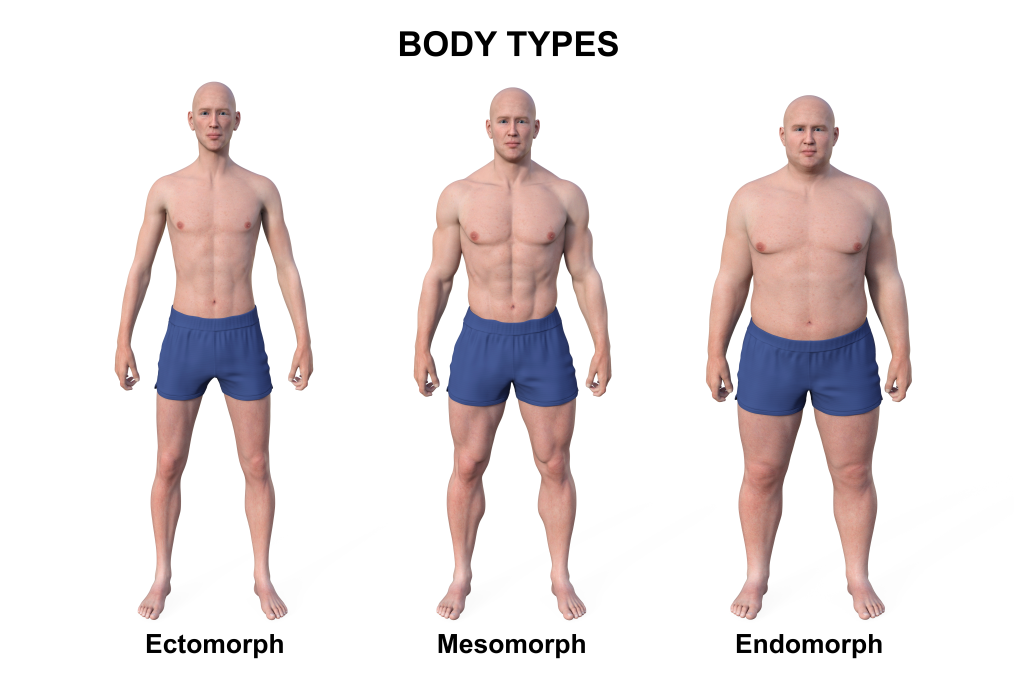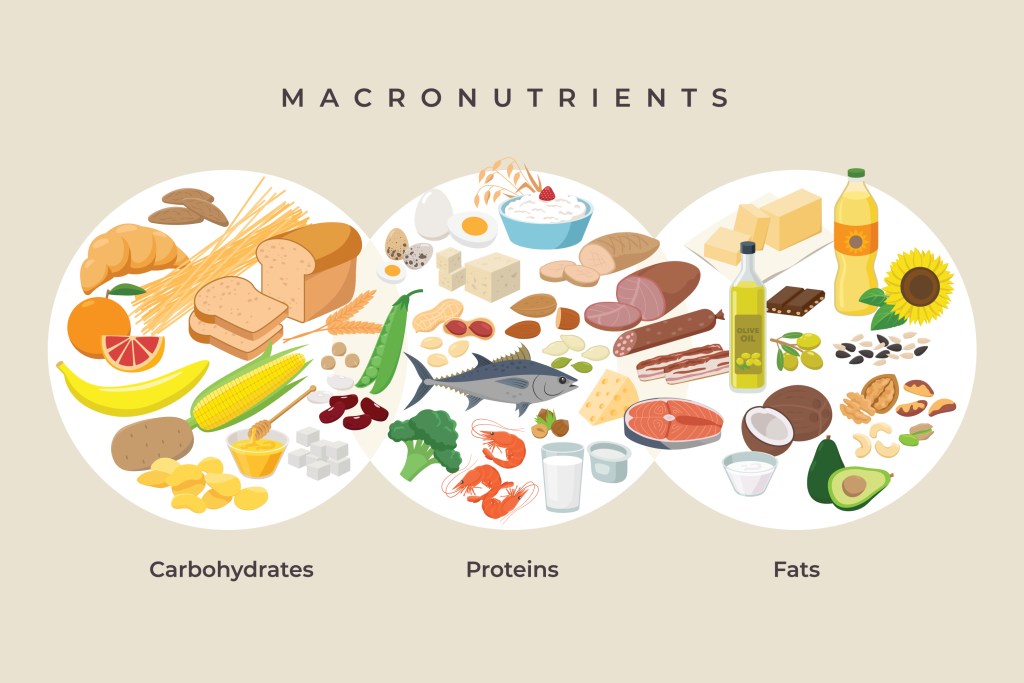At a glance
Endomorph body types often struggle with weight loss due to a naturally slower metabolism and a greater tendency to store fat. An effective endomorph diet emphasizes a low-carb, high-fat approach to support hormonal balance and promote fat burning. Combining this meal plan with intermittent fasting and regular exercise can further enhance metabolic efficiency and long-term weight control for endomorph body types.
Following a nutritious endomorph diet is key to achieving a healthy body weight for those who naturally store more body fat and struggle with a slower metabolism.
Find out if you have an endomorph body type and discover why a high-fat meal plan is the ideal diet for sustainable weight loss tailored to the unique metabolic needs of endomorphs.
What is the endomorph body type?
Endomorph body types are characterized by a larger, rounder frame and a predisposition to being overweight due to a naturally slower metabolism.
Compared to mesomorphs, who can easily gain muscle mass, endomorphs struggle to achieve muscle growth, gain weight quickly, and find losing weight challenging.
Endomorph body types are prone to excess body fat around the lower abdomen and typically have a round body frame, thick arms, and medium to large joints.
Because of their body composition and higher body fat percentage, endomorphs often develop insulin resistance. This serious metabolic imbalance causes poor blood sugar regulation, further contributing to weight gain and creating a vicious cycle of excess body fat and difficulty losing weight.
Research published in Diabetes, Metabolic Syndrome, and Obesity found that endomorph body types are at greater risk of excessive weight and obesity-related health issues than ectomorphs, who have a slender body frame and generally a faster metabolism.1
While genetics plays a crucial role in determining whether an individual develops an endomorphic body type, diet and exercise also influence body composition and metabolic health.
This highlights the importance of targeted dietary and lifestyle interventions to counteract the metabolic challenges, such as excess fat storage and insulin resistance, associated with an endomorph body type.

Metabolic vs. hormonal body types
Metabolic body types classify individuals based on natural tendencies of weight gain, fat storage, and muscle development.
The three different body types include:
- Ectomorphs
- Mesomorphs
- Endomorphs
In contrast, hormonal body types are shaped by hormonal imbalances that affect body composition, fat storage, and metabolic energy-making processes.
Imbalanced hormones can lead to persistent weight challenges and difficulty building muscle and may predispose the affected individuals to chronic health problems, including diabetes, heart disease, and cognitive issues.
Hormonal body types are generally categorized into five groups:
- Ovary body type
- Liver body type
- Thyroid body type
- Adrenal body type
- Pancreas body type
Restoring hormonal balance and tackling underlying health issues is crucial for individuals with hormonal body types. This approach not only helps achieve a healthier body composition but also reduces the risk of long-term medical complications.

What is the endomorph diet?
The endomorph diet is designed to address the unique metabolic needs of individuals with this body type, as they’re more prone to insulin resistance, which is largely caused by a high-carb diet.
Therefore, the most crucial aspect of the endomorph diet is limiting carbohydrate intake to maintain balanced blood sugar and insulin levels. Carbohydrate restriction, especially in combination with consuming plenty of healthy fats, also supports metabolic efficiency and promotes weight loss.
While individual approaches to the endomorph diet differ, it’s generally recommended to limit carbohydrates, consume plenty of lean proteins, incorporate healthy fats, and emphasize fruits, vegetables, legumes, and whole grains.
While there’s no strict macronutrient ratio, most endomorph diets recommend the following:
- 30 percent of daily calories from carbohydrates
- 35 percent of daily calories from lean protein
- 35 percent of calories from fat
In addition, many people following an endomorph diet pay close attention to calorie consumption, as their slow metabolism makes it easier to gain weight even with moderate food intake.

The keto diet vs. the endomorph diet
While both the ketogenic and endomorph diets focus on limiting carbohydrates, the ketogenic diet takes a more restrictive approach, limiting carb intake to no more than 50 grams per day to trigger and maintain ketosis.
This metabolic state shifts the body from using glucose as a fuel source to burning fat to generate energy.
In contrast, the endomorph diet permits significantly more carbohydrates, which prevents the body from entering ketosis and may explain why some individuals following this dietary approach don’t experience the same level of fat-burning efficiency as those on a ketogenic diet.
Keto also prioritizes higher fat intake and encourages moderate protein consumption, which helps the body burn fat for fuel while maintaining muscle mass.
“For endomorphs, protein is crucial, but lean protein might not be ideal for those with slower metabolisms,” explains Dr. Berg. “Keto’s higher fat ratio supports sustained energy levels and more significant weight loss, making it an ideal diet for those with an endomorph body type.”
Evidence published in The British Journal of Nutrition confirms the ketogenic diet’s effectiveness in reducing body fat and enhancing body composition.2
This highlights that a high-fat keto diet is an excellent strategy for achieving sustainable fat loss, as it shifts the body’s primary energy source from carbohydrates to fats.

Combining the keto diet and endomorph diet
Combining the ketogenic diet with the principles of the endomorph diet offers a powerful approach to losing body fat and improving overall health.
This combination helps stabilize blood sugar and insulin levels and encourages the body to burn stored fat for energy, an ideal strategy for endomorphs aiming to shed excess weight.
The ideal macronutrient ratio for a ketogenic diet designed for endomorphs includes:
- 70 percent of daily calories from healthy fats
- 20 percent of daily calories from protein
- 10 percent of daily calories from carbohydrates
To achieve this macronutrient ratio, it’s crucial to include plenty of healthy fats such as fatty fish, olive and coconut oil, avocados, seeds, nuts, grass-fed butter, and other full-fat dairy products to meet the body’s caloric needs while maintaining a metabolic state of fat-burning.
In addition, those transitioning from an endomorph to a ketogenic diet should avoid grains, cereals, legumes, starchy vegetables, and most fruits to keep carbohydrate intake low and sustain ketosis.
Instead, it’s crucial to focus on non-starchy vegetables such as leafy green vegetables, broccoli, cauliflower, and zucchini to provide essential nutrients without exceeding carbohydrate limits.
In addition to restricting carb intake, it’s equally important to ensure adequate nutrient intake to support optimal metabolic health, hormonal balance, and overall well-being.
That’s why it’s vital to follow Healthy Keto®, an advanced ketogenic diet that avoids processed foods while emphasizing nutritious whole options such as grass-fed beef, organic vegetables, high-fat dairy, wild-caught game meat and fish, seafood, seeds, and nuts.

Weight loss tips for endomorphs
In addition to following a nutritious low-carb diet, various other effective strategies can help individuals with an endomorph body type achieve a healthy weight and support overall health.
Here are three weight loss tips for endomorphs.
1. Practice intermittent fasting
Intermittent fasting can be a powerful tool for endomorphs to promote fat loss and support metabolic health.
Restricting food intake to a six- or eight-hour eating window allows the body prolonged periods to burn stored body fat for energy, which is particularly effective when intermittent fasting is combined with a Healthy Keto diet.
A study published in Nature highlights the benefits of intermittent fasting in combination with a ketogenic diet, especially regarding sustained weight loss and improved insulin sensitivity, which is crucial for endomorphs.3
The authors concluded, “After 26 weeks, intermittent fasting substantially reduced insulin resistance.” This highlights intermittent fasting’s potential to counteract the metabolic challenges specific to individuals with an endomorphic body type.
If you’re unsure, learning what is my body type can help you determine the best approach for your needs.

2. Avoid snacking
Not snacking in between meals not only helps moderate calorie consumption but also avoids blood sugar and insulin fluctuations throughout the day.
Even healthy snacks can trigger insulin release, which, over time, can reduce the body’s sensitivity to insulin. This diminished response can contribute to insulin resistance, hindering weight loss and negatively impacting overall metabolic health.
This explains why snacking is often considered one of the biggest weight loss mistakes, as it disrupts the body’s natural fat-burning process and promotes fat storage.
3. Built lean muscle mass
In addition to following a healthy diet, building lean muscle mass is essential for endomorphs to boost metabolic energy-making processes and improve body composition.
High-intensity interval training (HIIT) is particularly effective for this body type as it combines strength training and cardio to maximize fat-burning while promoting muscle growth.
Muscle tissue holds the highest concentrations of mitochondria, cellular organelles responsible for producing energy. Increasing muscle mass enhances mitochondrial density, which boosts the body’s metabolic rate, thereby supporting weight loss and improving metabolic health and endurance.
Key takeaways
- Endomorph body types tend to gain weight easily and often benefit from a diet that limits carbohydrates and emphasizes healthy fats.
- A low-carb, high-fat approach such as Healthy Keto supports fat-burning and helps balance insulin and blood sugar levels.
- Combining a ketogenic endomorph diet with intermittent fasting can significantly enhance fat loss and metabolic health.
- Targeted strength training and HIIT workouts help boost metabolic efficiency in endomorph body types by increasing lean muscle mass.
FAQ
1. Can I combine the keto diet and the endomorph diet?
Yes, the keto diet can be effectively combined with the endomorph diet to promote fat loss and improve metabolic health.
In fact, the more stringent carbohydrate restriction of the keto diet is particularly beneficial for endomorphs, who are more prone to insulin resistance, a serious metabolic imbalance typically linked to a high-carb diet.
2. What should an endomorph eat to lose weight?
It’s recommended that endomorphs obtain the majority of calories from healthy fats such as avocados, olive oil, coconut oil, fatty fish, nuts, seeds, and grass-fed butter to support fat-burning and sustained energy levels.
In addition, this body type benefits from moderate amounts of high-quality protein sources, including grass-fed beef, wild-caught fish and game meat, and full-fat dairy products.
3. What are the characteristics of the endomorph body type?
The endomorph body type is characterized by a naturally higher body fat percentage, a wider body frame and waistline, and a tendency to gain weight quickly.
In addition, individuals with an endomorph body type typically have a slower metabolism and often struggle to lose excess fat, especially around the abdomen.
4. What is the best type of exercise for endomorphs?
A well-rounded fitness program that includes high-intensity interval training (HIIT), weightlifting, resistance exercises, and light cardio workouts is ideal for endomorphs as it supports weight loss while promoting muscle growth.
5. How many carbs should an endomorph eat to lose weight?
It’s recommended that those with an endomorph body type restrict carbohydrate intake to no more than 50 grams daily to trigger ketosis, a metabolic state of fat-burning.
This carb restriction not only supports sustainable weight loss but also helps reduce the risk of insulin resistance, a metabolic imbalance that tends to affect endomorphs more than other body types.
6. What foods should endomorphs avoid?
Endomorphs should avoid processed foods, sugars, and other carbohydrate-rich foods such as grains, cereals, rice, pasta, bread, starchy vegetables, and most fruits.
These foods trigger blood sugar fluctuations and insulin spikes, which promote fat storage and disrupt metabolic functions, making it harder for endomorphs to maintain a healthy weight.
Sources
- https://pmc.ncbi.nlm.nih.gov/articles/PMC7894874/ ?
- https://pmc.ncbi.nlm.nih.gov/articles/PMC9244428/ ?
- https://www.nature.com/articles/s44324-024-00025-2 ?











